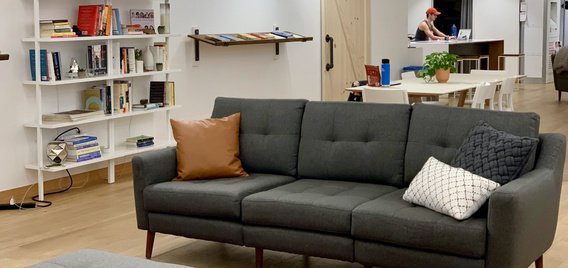Burrow products are present at Lululemon's Hub Seventeen space in New York City. |
Credit: Burrow
Direct-to-consumer (DTC) companies, by definition, cut out the middleman and find fresh ways of selling products in an industry. Often these disruptors start by operating exclusively online. And for a while, it works.
But "imitation is the greatest form of flattery," Ray Hartjen, marketing director at RetailNext, told Retail Dive in an interview. "There's increased competition going after the same customers and online that can get prohibitively expensive — the cost of acquiring new customers and winning search."
Eventually, these digital natives must venture into brick and mortar, at least in some capacity. "Many times you'll have direct-to-consumer brands simply look at rent as search," Hartjen said. For companies that operate exclusively online, remaining at the top of search and top of mind becomes increasingly difficult, especially for brands in the furniture space, an infrequent purchase category.
These companies use brick-and-mortar locations as a "physical webpage for their business" that gives the brand an opportunity to put themselves in front of new sets of customers in various markets.
DTC mattress company Casper, which was founded in 2014, announced a year ago it would open 200 stores across North America. Warby Parker, which some consider the original disruptor, now has more than 100 locations across North America. For some companies, temporary pop-up shops are the best option as a way to roll out a new product line or dip their toes into the brick-and-mortar waters.
For others, however, permanent locations or pop-ups aren't feasible options. Those companies must look to alternatives.
Why do companies explore alternatives?
Stephen Kuhl, co-founder and CEO of furniture company Burrow, knew that while physical stores were necessary, they were also costly. "To be fully honest, we didn't have enough money to open up stores," he told Retail Dive in an interview.
Instead, the company used creative ways to help customers to find its products through partnerships with coworking spaces, coffee shops and other retail spaces.
"What was different about sofas, versus eyeglasses or razors, is that you can put a sofa in a public place, and it's not weird," Kuhl said.
Many coffee shops have also normalized this trend by displaying art by local artists and giving customers the opportunity to purchase them. Kuhl said that while Burrow has since ended its partnerships with coffee shops after it discovered muffin crumbs between the couch cushions didn't make for a good customer experience, it's still forming others.
Burrow has collaborated with retailers like Lululemon, Bailey 44 and The Groomsman Suit to give customers the chance to see its products before deciding whether they want to order.
These kind of partnerships are a "win-win," Kuhl said. Potential customers can see the product before committing to purchasing and the retail stores get increased foot traffic.
Burrow isn't alone in exploring alternative methods to traditional furniture showrooming.


